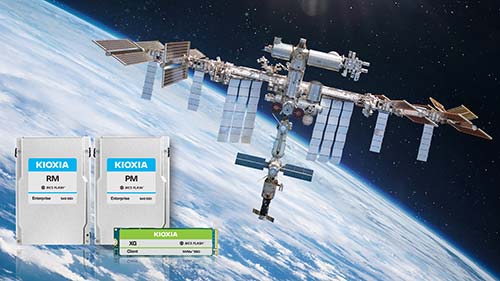 Today, KIOXIA SSDs took flight with the launch of the NG-20 mission rocket, which is delivering an updated HPE Spaceborne Computer-2, based on HPE EdgeLine and ProLiant servers from Hewlett Packard Enterprise (HPE), to the International Space Station (ISS). KIOXIA SSDs provide robust flash storage in HPE Spaceborne Computer-2 to conduct scientific experiments aboard the space station.
Today, KIOXIA SSDs took flight with the launch of the NG-20 mission rocket, which is delivering an updated HPE Spaceborne Computer-2, based on HPE EdgeLine and ProLiant servers from Hewlett Packard Enterprise (HPE), to the International Space Station (ISS). KIOXIA SSDs provide robust flash storage in HPE Spaceborne Computer-2 to conduct scientific experiments aboard the space station.
HPE Spaceborne Computer-2, based on commercial off-the-shelf technology, provides edge computing and AI capabilities on board the research outpost as part of a greater mission to significantly advance computing power in space and reduce dependency on communications as space exploration continues to expand. Designed to perform various high-performance computing (HPC) workloads in space, including real-time image processing, deep learning, and scientific simulations, HPE Spaceborne Computer-2 can be used to compute a number of experiment types including healthcare, natural disaster recovery, 3D printing, 5G, AI, and more.
As the data storage provider for the HPE Spaceborne Computer-2, KIOXIA has provided flash memory-based SSDs, including KIOXIA RM Series value SAS, PM Series enterprise SAS and XG Series NVMeTM SSDs, to enable these advancements. In addition to eight 1,024 gigabyte (GB) NVMe and four 960 GB value SAS SSDs, each of the four enterprise SAS SSDs provided by KIOXIA have a capacity of 30.72 terabytes (TB) for a total of more than 130TB – the most data storage to travel to the space station on a single mission.1
Flash memory-based SSDs are better-suited than traditional hard disk drive storage to withstand the power, performance and reliability requirements of outer space, as they have no moving parts, are less susceptible to electromagnetic waves and provide faster performance. SSD health will be monitored daily throughout the duration of the mission, with daily log files transmitted from the ISS. KIOXIA will track and analyze this health data in order to better understand how flash memory storage operates in the harsh environment of space.
“The convergence of memory technology and space exploration are set to take scientific discovery and innovation beyond the confines of Earth,” said Caesar Ichimura, Chief Marketing Officer, KIOXIA Corporation. “KIOXIA is proud to be a part of this mission, taking science and information technology to the next level.”
KIOXIA has been collaborating with HPE to create best-in-class storage solutions for years, and the company’s products enable a broad range of HPE solutions and services, from mobile to the cloud to the enterprise.
“We’re extremely proud to return to space, building upon on the success of the HPE Spaceborne Computer’s previous missions to help enhance the pace of insight and innovation within the scientific community,” said Jim Jackson, Chief Marketing Officer, HPE. “We’re pleased to work with KIOXIA as we continue to push the boundaries of what HPE’s state-of-the-art system can do with additional storage, such as enabling much more sophisticated research aboard the space station to help make significant breakthroughs.”


